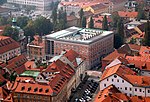Ljubljana Summer Festival
1953 establishments in SloveniaCenter District, LjubljanaCultural events in LjubljanaFestival stubsFestivals in Slovenia ... and 3 more
Music festivals established in 1953Slovenia stubsSummer events in Slovenia

The Ljubljana Summer Festival is a festival held between July and August in Ljubljana, the capital of Slovenia. It attracts notable opera stars, ballet and theatre performers and also eminent rock and jazz musicians internationally who perform at the festival.
Excerpt from the Wikipedia article Ljubljana Summer Festival (License: CC BY-SA 3.0, Authors, Images).Ljubljana Summer Festival
Križevniška soteska, Ljubljana Trnovo
Geographical coordinates (GPS) Address Nearby Places Show on map
Geographical coordinates (GPS)
| Latitude | Longitude |
|---|---|
| N 46.046597222222 ° | E 14.503122222222 ° |
Address
Srednja šola za oblikovanje in fotografijo Ljubljana
Križevniška soteska
1102 Ljubljana, Trnovo
Slovenia
Open on Google Maps







